
How to Use Capacitive Soil Moisture V2.00: Examples, Pinouts, and Specs
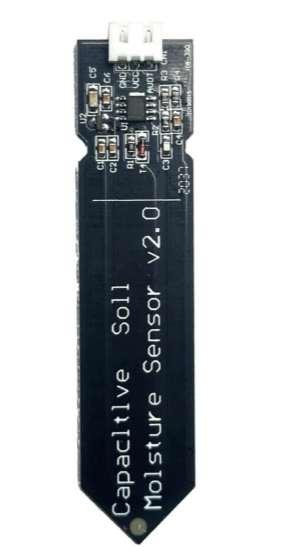
 Design with Capacitive Soil Moisture V2.00 in Cirkit Designer
Design with Capacitive Soil Moisture V2.00 in Cirkit DesignerIntroduction
The Capacitive Soil Moisture V2.00 by Generico is a sensor designed to measure the volumetric water content in soil using advanced capacitive sensing technology. Unlike traditional resistive soil moisture sensors, this sensor avoids corrosion, ensuring long-term durability and reliable performance. It provides accurate moisture readings, making it ideal for applications in agriculture, gardening, and environmental monitoring.
Explore Projects Built with Capacitive Soil Moisture V2.00
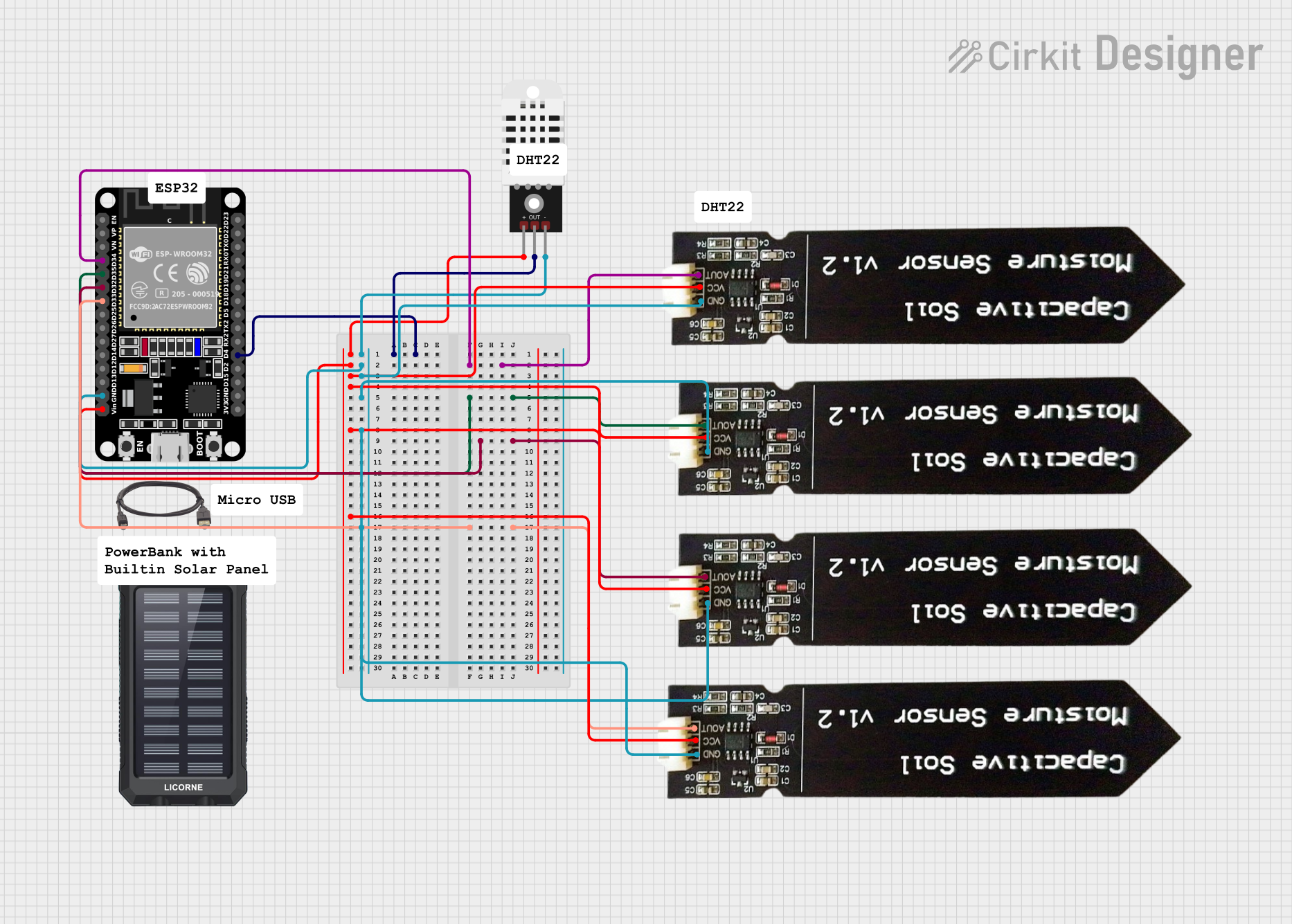
 Open Project in Cirkit Designer
Open Project in Cirkit Designer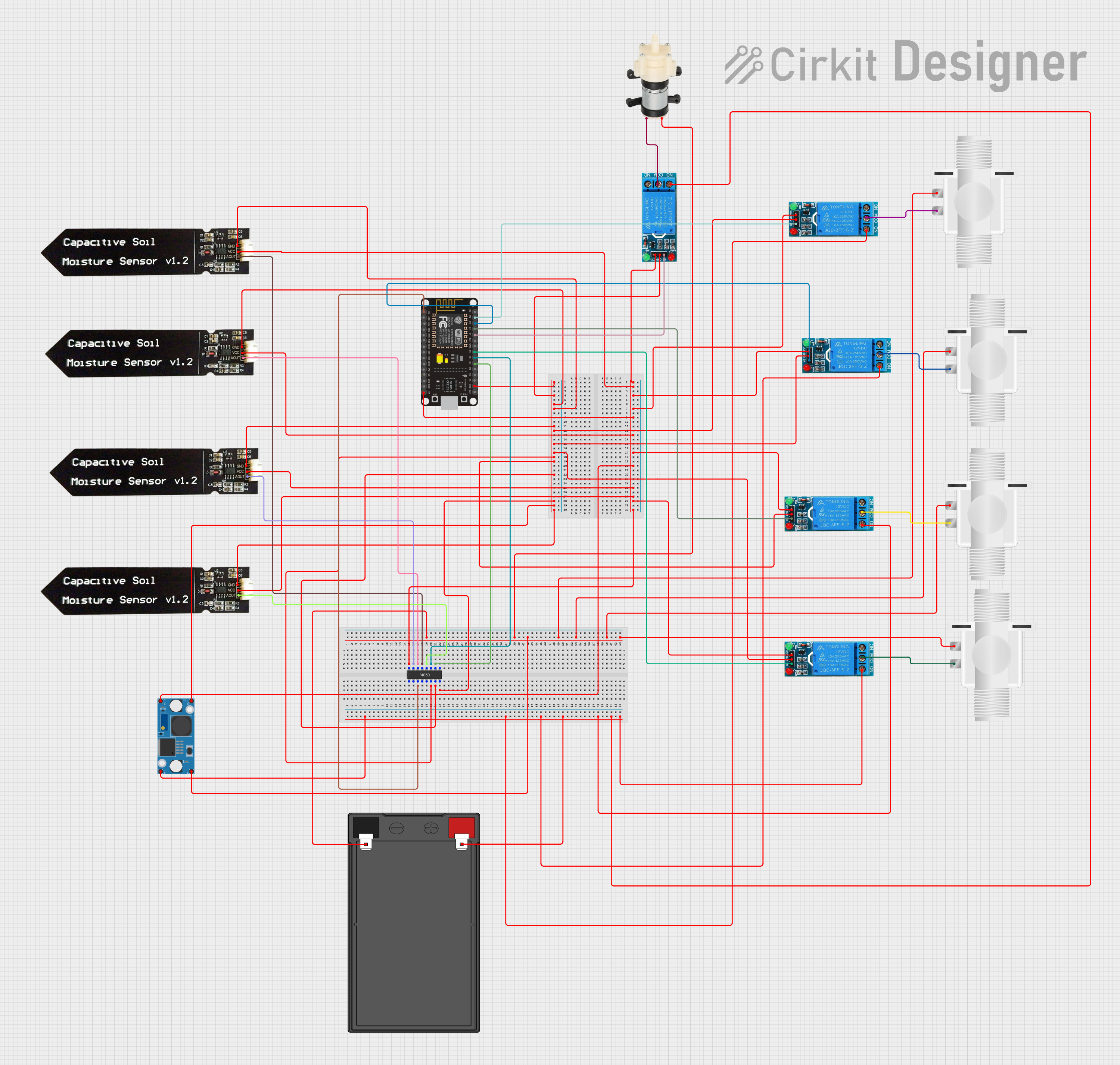
 Open Project in Cirkit Designer
Open Project in Cirkit Designer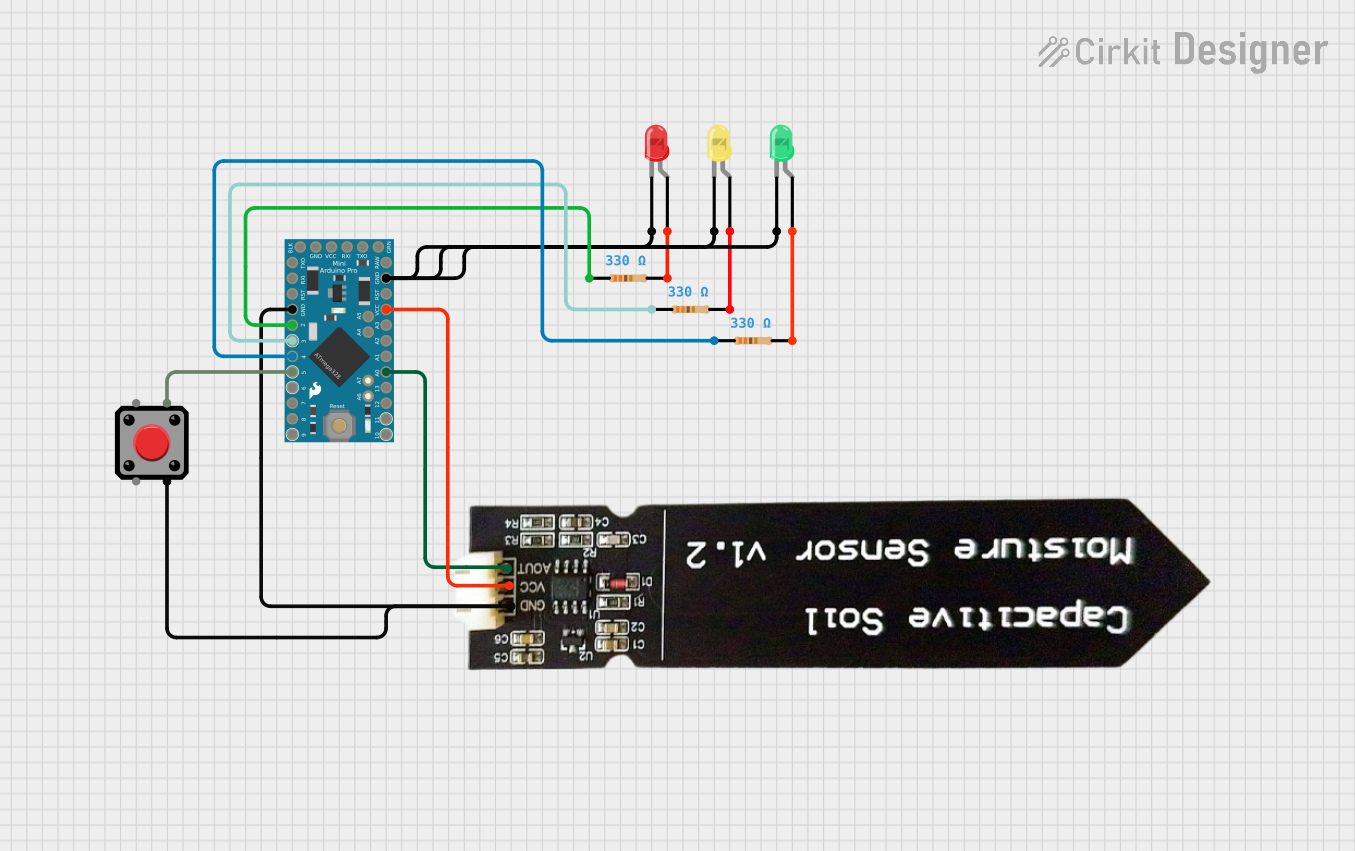
 Open Project in Cirkit Designer
Open Project in Cirkit Designer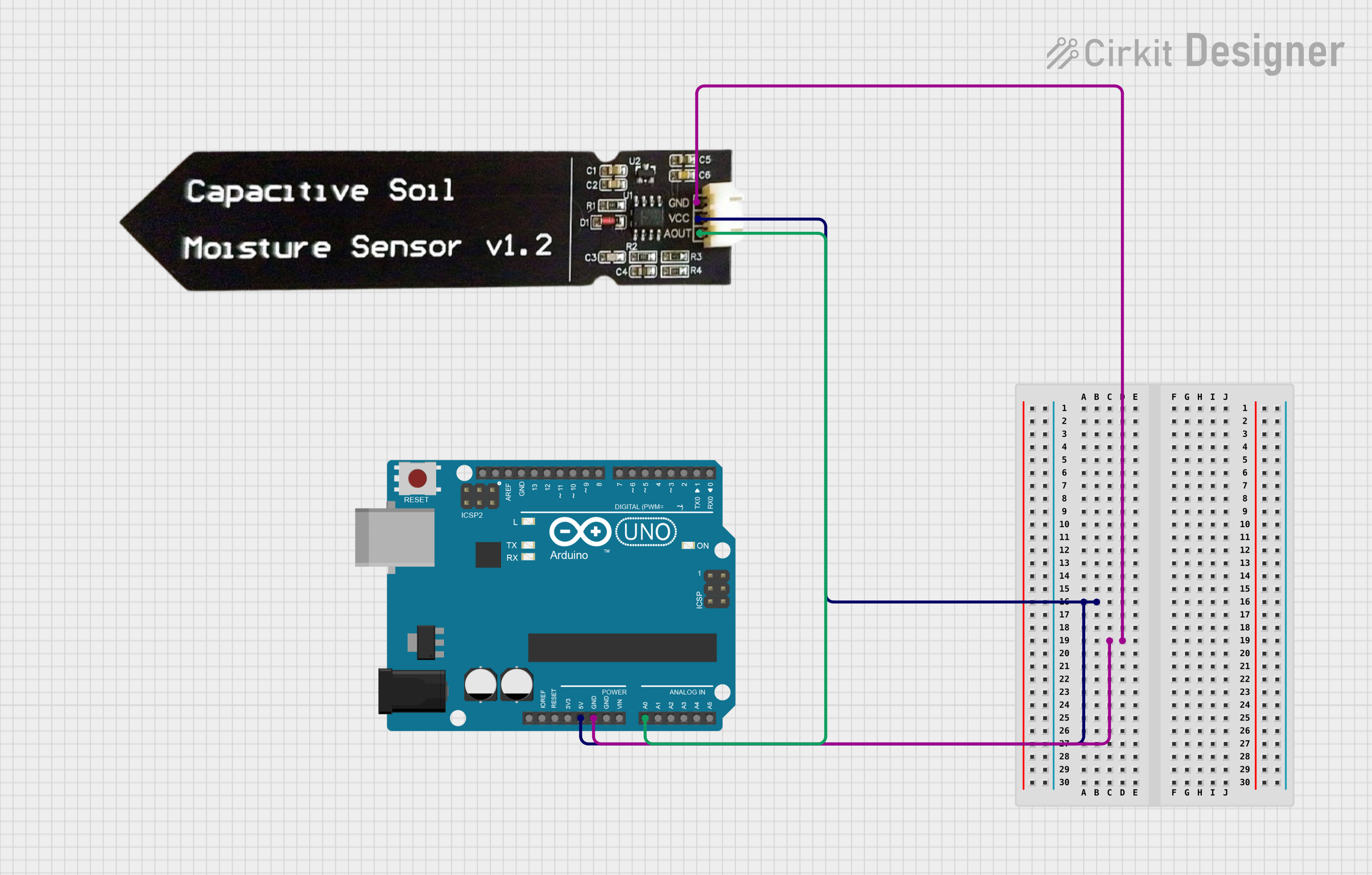
 Open Project in Cirkit Designer
Open Project in Cirkit DesignerExplore Projects Built with Capacitive Soil Moisture V2.00

 Open Project in Cirkit Designer
Open Project in Cirkit Designer
 Open Project in Cirkit Designer
Open Project in Cirkit Designer
 Open Project in Cirkit Designer
Open Project in Cirkit Designer
 Open Project in Cirkit Designer
Open Project in Cirkit DesignerCommon Applications and Use Cases
- Smart irrigation systems: Automate watering schedules based on soil moisture levels.
- Agriculture: Monitor soil conditions to optimize crop growth.
- Gardening: Maintain healthy plants by ensuring proper soil moisture.
- Environmental monitoring: Track soil moisture trends for research and analysis.
Technical Specifications
The following table outlines the key technical details of the Capacitive Soil Moisture V2.00 sensor:
| Parameter | Value |
|---|---|
| Operating Voltage | 3.3V - 5.5V |
| Output Signal | Analog voltage (0-3.0V typical) |
| Current Consumption | < 20mA |
| Measurement Range | 0% - 100% soil moisture |
| Dimensions | 98mm x 23mm x 3mm |
| Interface Type | Analog |
| Operating Temperature | -40°C to 85°C |
Pin Configuration and Descriptions
The Capacitive Soil Moisture V2.00 sensor has a simple 3-pin interface:
| Pin | Name | Description |
|---|---|---|
| 1 | VCC | Power supply input (3.3V to 5.5V) |
| 2 | GND | Ground connection |
| 3 | AOUT | Analog output signal proportional to soil moisture |
Usage Instructions
How to Use the Sensor in a Circuit
Connect the Sensor:
- Connect the VCC pin to a 3.3V or 5V power source.
- Connect the GND pin to the ground of your circuit.
- Connect the AOUT pin to an analog input pin on your microcontroller (e.g., Arduino).
Power the Circuit:
- Ensure the power supply voltage is within the specified range (3.3V to 5.5V).
Read the Analog Signal:
- The sensor outputs an analog voltage signal on the AOUT pin. This voltage is proportional to the soil moisture level, where a higher voltage indicates drier soil and a lower voltage indicates wetter soil.
Important Considerations and Best Practices
- Placement: Insert the sensor into the soil vertically, ensuring the sensing area is fully covered by soil for accurate readings.
- Calibration: For precise measurements, calibrate the sensor by recording the analog output in dry and saturated soil conditions.
- Avoid Damage: Do not bend the sensor excessively or expose it to physical stress.
- Power Supply: Use a stable power source to avoid fluctuations in the output signal.
Example: Using the Sensor with an Arduino UNO
Below is an example code snippet to read soil moisture data using an Arduino UNO:
// Define the analog pin connected to the sensor's AOUT pin
const int sensorPin = A0;
void setup() {
Serial.begin(9600); // Initialize serial communication at 9600 baud
pinMode(sensorPin, INPUT); // Set the sensor pin as an input
}
void loop() {
int sensorValue = analogRead(sensorPin); // Read the analog value from the sensor
float voltage = sensorValue * (5.0 / 1023.0); // Convert the value to voltage
// Map the voltage to a percentage (0% to 100% soil moisture)
int moisturePercent = map(sensorValue, 0, 1023, 0, 100);
// Print the results to the Serial Monitor
Serial.print("Soil Moisture: ");
Serial.print(moisturePercent);
Serial.println("%");
delay(1000); // Wait for 1 second before the next reading
}
Notes on the Code
- The
map()function is used to convert the raw analog reading into a percentage value. - Adjust the mapping range (
0, 1023) if you calibrate the sensor for specific soil conditions.
Troubleshooting and FAQs
Common Issues and Solutions
No Output Signal:
- Cause: Incorrect wiring or insufficient power supply.
- Solution: Double-check the connections and ensure the power supply voltage is within the specified range.
Inconsistent Readings:
- Cause: Loose connections or unstable power supply.
- Solution: Secure all connections and use a regulated power source.
Sensor Not Responding:
- Cause: Sensor damaged or exposed to extreme conditions.
- Solution: Inspect the sensor for physical damage and replace if necessary.
Output Signal Does Not Change:
- Cause: Sensor not properly inserted into the soil.
- Solution: Ensure the sensor is fully inserted into the soil and the sensing area is covered.
FAQs
Q: Can this sensor be used in saline or highly acidic soil?
A: While the sensor is resistant to corrosion, extreme soil conditions may affect its accuracy. Calibration is recommended for such environments.
Q: How do I calibrate the sensor?
A: Measure the analog output in completely dry soil and fully saturated soil. Use these values to adjust the mapping range in your code.
Q: Is the sensor waterproof?
A: The sensing area is designed to be inserted into soil, but the electronic components should not be submerged in water. Protect the top portion of the sensor from moisture.
Q: Can I use this sensor with a 3.3V microcontroller?
A: Yes, the sensor operates within a voltage range of 3.3V to 5.5V, making it compatible with 3.3V systems like ESP32 or Raspberry Pi.
By following this documentation, you can effectively integrate the Capacitive Soil Moisture V2.00 sensor into your projects and ensure reliable performance.